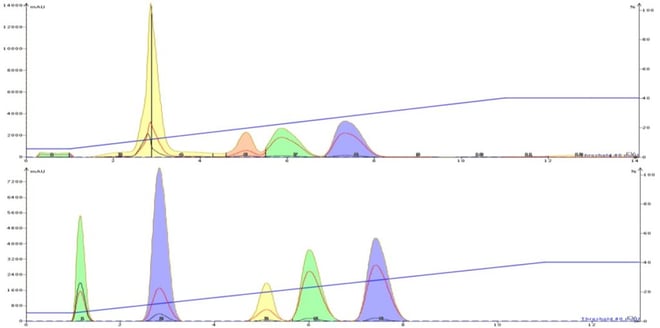Silica is the most commonly used sorbent for flash column chromatography. When solvent is pumped through a column packed with dry silica you may notice it gets warm and sometimes down right hot!
In this post I will attempt to explain why this phenomena occurs.
Flash chromatography is a widely utilized purification methodology. Typically used with non-polar and moderately polar solvents and columns packed with silica, this technique has the ability to separate compounds with different polarities and functional groups.
With bulk silica, as well as pre-packed flash cartridges, the media is “active”, meaning it is dry. Because silica is also an adsorbent media, as solvent passes through it several things happen…
- -The solvent displaces the air in the silica's pores
- -The solvent adsorbs to the silica surface and generates heat
- -Friction builds
It is the adsorption process that generates the initial "heat band” and the more polar the solvent, the greater the heat generated. This phenomena is known as the heat of adsorption.
Since silica has a polar surface it preferentially adsorbs polar solvents. The solvent’s polarity and heat capacity influence the amount of heat generated during the initial solvent-sorbent interaction. This is the main reason silica flash cartridges are equilibrated prior to sample injection as the generated heat will negatively influence mass-transfer kinetics and compound retention/separation.
Once fully equilibrated just the act of pumping solvent through the packed column generates friction, and therefore heat. The amount of heat generated is dependent upon media particle size, flow rate, and solvent viscosity but is typically very low in flash chromatography.
Is this a concern in your daily flash chromatography? Only if you do not equilibrate your flash cartridge/column prior to loading your sample, Figure 1. It is not a concern with reversed-phase or other bonded silicas as these media are bonded and therefore, deactivated.
 Figure 1. Impact of heat on chromatographic performance. Top - flash chromatography using a hexane/ethyl acetate gradient without equilibration generates enough heat to disrupt the adsorption/desorption kinetics which reduces performance compared to an equilibrated cartridge (bottom) where the heat has been removed.
Figure 1. Impact of heat on chromatographic performance. Top - flash chromatography using a hexane/ethyl acetate gradient without equilibration generates enough heat to disrupt the adsorption/desorption kinetics which reduces performance compared to an equilibrated cartridge (bottom) where the heat has been removed.
Interested in learning more about flash chromatography? Click below to download our white paper - Successful Flash Chromatography

 Organic Workflow
Organic Workflow Peptide Workflow
Peptide Workflow Scale-Up Flash Purification
Scale-Up Flash Purification  Sample Preparation
Sample Preparation Biomolecule Purification
Biomolecule Purification Oligo synthesis
Oligo synthesis Scavengers and Reagents
Scavengers and Reagents Service & Support
Service & Support Accessories & Spare parts
Accessories & Spare parts Investors
Investors Reports & News
Reports & News The Share
The Share Corporate Governance
Corporate Governance Calendar
Calendar Sustainability
Sustainability Our Offering
Our Offering Our History
Our History Our Locations
Our Locations Leadership
Leadership